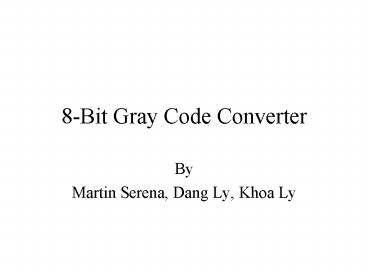8-Bit Gray Code Converter - PowerPoint PPT Presentation
1 / 58
Title:
8-Bit Gray Code Converter
Description:
Gray Code Background. Conversion works in both directions. Binary Gray , Gray Binary ... Connected gate layouts to create device layouts ... – PowerPoint PPT presentation
Number of Views:1093
Avg rating:3.0/5.0
Title: 8-Bit Gray Code Converter
1
8-Bit Gray Code Converter
- By
- Martin Serena, Dang Ly, Khoa Ly
2
Overview
- Gray Code Background
- Delegated Duties
- Method of Design
- Target Specifications
- Simulation Results
- Block Diagram
- Schematics, Symbols, Layouts, and Simulations
- Design References
- Conclusion
3
Gray Code Background
- Conversion works in both directions
- Binary ? Gray , Gray ? Binary
- One bit changes from number to number
- Not arithmetic
- Not weighted (e.g. 222120)
- Limits the amount of error that can occur when
several bits change between numbers - No limit to number of converted bits
4
Binary to Gray Code Conversion
1
1
0
0
(BC)
1
0
0
1
(GC)
- MSB does not change as a result of conversion
- Start with MSB of binary number and add it to
neighboring binary bit to get the next Gray code
bit - Repeat for subsequent Gray coded bits
5
Gray to Binary Code Conversion
1
0
1
0
(GC)
1
0
1
0
(BC)
- MSB does not change as a result of conversion
- Start with MSB of binary number and add it to the
second MSB of the Gray code to get the next
binary bit - Repeat for subsequent binary coded bits
6
Delegated Duties
- Martin Binary to Gray Conversion,
Gray to Binary Conversion (XOR gates) - Dang Binary/Gray Output Selection
(MUXs) - Khoa Binary Code Counter,
- Parallel-to-Parallel Shift
Register (D flip-flops)
7
Method of Design
- Decided on an initial load capacitance (Cin)
- Partitioned the circuit into different
propagation delay times according to gate/device
requirements, and divided propagation delay times
amongst the individual gates and devices - Created the symbol and layout for out each type
of gate (XOR, MUX, NAND) - Connected gate symbols to create device symbols
- Connected gate layouts to create device layouts
- Connected device symbols to create circuit
schematics, and connected device layouts to
create circuit layouts
8
Target Specifications
- Conversion
- Binary Code to Gray Code
- Gray Code to Binary Code
- Propagation delay times
- XOR (each) 0.4 nS
- MUX (each) 0.3 nS
- D flip-flop (each) 0.63 nS (worst-case fall
time) - Technology specs (size)
- Minimum Channel Width 1.5 ?m
- Minimum Channel Length 0.6 ?m
- Power lt ¼ Watt
- Clock Speed 200 MHz
- Total area as small as possible
9
Simulation Results
- Successfully converts binary and Gray codes
- Propagation Delay
- XOR (each) 0.338 nS (worst-case)
- MUX (each) 0.35 nS (worst-case)
- D flip-flop (each) 1.14 nS (worst-case fall
time) - Technology specs (size)
- Transistor Lengths 0.6 ?m
- XOR Wp 3.9 ?m Wn 3.75 ?m
- MUX Wp 6 ?m Wn 3 ?m
- D Flip-Flop Wp 18 ?m Wn 10 ?m
10
Simulation Results
- Power (using the power meter)
- 39.94 mW
- Clock Speed
- 200 MHz
- Total Area
- Gray code converter 6.03E-4 cm2
- Counter 10.2E-4 cm2
11
Block Diagram
12
XOR Schematic
13
XOR Symbol
14
XOR Layout
15
XOR Extracted
16
XOR LVS Report
17
XOR Test Bench
18
XOR Transient Analysis
19
XOR Threshold
20
MUX Schematic
21
MUX Symbol
22
MUX Layout
23
MUX Extracted
24
MUX LVS Report
25
MUX Test Bench
26
MUX Transient Analysis
27
MUX Transient Analysis
28
NAND3 Schematic
29
NAND3 Symbol
30
NAND3 Layout
31
NAND3 Extracted
32
NAND3 LVS Report
33
NAND3 Test Bench
34
NAND3 Transient Analysis
35
D Flip-Flop Schematic
36
D Flip-Flop Symbol
37
D Flip-Flop Layout
38
D Flip-Flop Extracted
39
D Flip-Flop LVS Report
40
D Flip-Flop Test Bench
41
D Flip-Flop Transient Analysis
42
Counter Schematic
43
Counter Symbol
44
Counter Layout
45
Counter Extracted
46
Counter LVS Report
47
Counter Transient Analysis
48
Gray Code Converter Schematic
49
Gray Code Converter Symbol
50
Gray Code Converter Layout
51
Gray Code Converter Extracted
52
Gray Code Converter LVS Report
53
Gray Code Converter Test Circuit
54
Gray Coded Transient Analysis
55
Binary Coded Transient Analysis
56
Power
57
Design References
- CMOS Integrated Circuits
- By Kang
- Digital Fundamentals
- Thomas Floyd
58
Conclusion
- We designed and simulated a Gray code converter
that converts binary coded numbers to Gray coded
numbers and vice versa - The nmos and pmos transistor widths were greater
than 1.5 ?m - The power specifications were well below ¼ Watt
and a code conversion took place within 5 nS - Our target specifications were met































